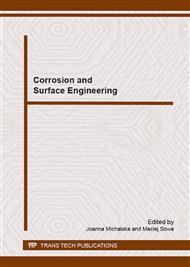p.393
p.397
p.401
p.405
p.409
p.413
p.417
p.421
p.425
The Morphology of Corrosion Products in FeAl Alloys after Heat-Resistance Tests at Different Temperatures
Abstract:
The alloys based on intermetallic phases involving Al belong to a new group of heat-resistant materials. Their physico-chemical and mechanical properties allow to apply them in the operating conditions in corrosive environment and elevated temperature. Research conducted for many years has shown that these materials can work at temperature up to 1100°C without degradation of their occurrence in the environment containing oxygen and sulphur. Heat resistance of these materials is provided by forming the Al2O3 passive layer on the surface. This layer is a protective barrier, which hinders the oxygen diffusion into the surface. This paper presents the morphology of passive Al2O3 layer depending on the temperature of its formation. The study allows to define the surface condition for corrosion products carried out using scanning electron microscopy together with EDS X-ray microanalysis.
Info:
Periodical:
Pages:
409-412
Citation:
Online since:
January 2015
Authors:
Keywords:
Price:
Сopyright:
© 2015 Trans Tech Publications Ltd. All Rights Reserved
Share:
Citation:


